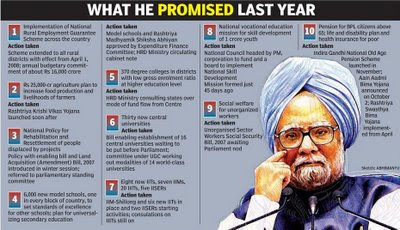
The world economy is recovering, and the price of oil too. It has crossed $70/barrel, and could return to $150/barrel, if the recovery continues. Can India do anything new to meet this energy challenge?
Yes, it can change its exploration policy to harness a new energy source — shale gas. No Indian has paid attention to the dramatic emergence of shale gas in the US, which has produced a gas glut. This has slashed the US price of natural gas by 75% from its peak in mid-2008. India must learn from this.
Shale is a common rock formation across the world. India has huge shale deposits across the Gangetic plain, Assam, Gujarat, Rajasthan, and many coastal areas. Gas has long been found in shale across the world, but its extraction has been viewed as uneconomic because of shale’s low permeability — gas does not flow easily through this rock. So, exploration for oil and gas has traditionally focused on limestone and sandstone, which have high permeability.
However, in the 1990s a new drilling technology emerged. A tight shale deposit could be cracked open by injecting water into wells at high pressure. When the water injection stopped, the cracks closed again. But then engineers hit on the idea of pumping water mixed with sand.
The sand kept cracks partially open when water injection stopped, increasing permeability and gas flow.
A sedimentary rock deposit has a limited depth but very wide area (sometimes hundreds of square miles). Traditional vertical drilling into a deposit 20 metres deep can yield gas production from a zone of just 20 metres. But new techniques have facilitated horizontal drilling. This makes possible horizontal wells running hundreds of metres long through shale strata, greatly increasing the production zone of each well. Horizontal drilling plus sand cracking have revolutionized the economics of shale gas in the US, and made it a boom industry.
Huge shale deposits lie at shallow depths across the world, and can be explored at a tiny fraction of the hundreds of millions involved in deep offshore wells (as in the Krishna-Godavari basin). The low cost per well compensates for the low yield per well. The share of shale gas in the US gas production has moved up from zero to 8%. One single deposit, the Barnett Shale in Texas, produced 1.1 trillion cubic feet of gas in 2008, and other deposits (Bakken, Haynesville) could be as productive. Anadarko Petroleum is ramping up drilling in the relatively lowyielding Marcellus Shale (stretching hundreds of miles from West Virginia to New York), aiming to achieve a 10% rate of return at a gas price of $2.50/mm British Thermal Unit. This is well below the current US price of $3.70, and a fraction of the $13 in June 2008. It is also well below the $4.20 the government has fixed for KG basin gas, and is close to the $2.34 Anil Ambani is demanding. So, at least some shale gas deposits look entirely economic.
Why has no company in India explored for shale gas despite several rounds of bidding for exploration blocks in the last two decades? The sad answer is that our exploration policy allows companies to produce only conventional oil and gas from their exploration blocks. If they find non-conventional energy — such as coal-bed methane or shale gas — they are forbidden to produce this! Why? Because, the petroleum ministry regards any non-conventional deposit as an unwarranted windfall for the exploring company, and wants separate bidding for non-conventional energy. For coalbed gas, it has called for bids and awarded exploration contracts in known coal deposits. But gas can also be found in deep coal deposits unknown today. When drilling for oil, Indian companies have already hit thick coal seams deep underground, but not bothered to test these for gas because they would not be allowed to extract it.
The same holds for shale gas. When drilling for oil, every company hits shale deposits, but ignores their gas potential since they are not allowed to harness it.
Clearly, two changes in exploration policy are urgently needed. First, the government needs to come out with a shale gas policy. It should facilitate seismic surveys that can quickly delineate potential shale gas deposits, and then invite bids for exploration.
Second, all future exploration contracts for oil should permit exploitation of shale gas as well as conventional gas. That will make it worthwhile for companies to investigate shale gas they may find while drilling for conventional hydrocarbons.
These policy changes will not cost the government a rupee. They will simply relax the boundaries of exploration. That alone can make a big difference.






























































